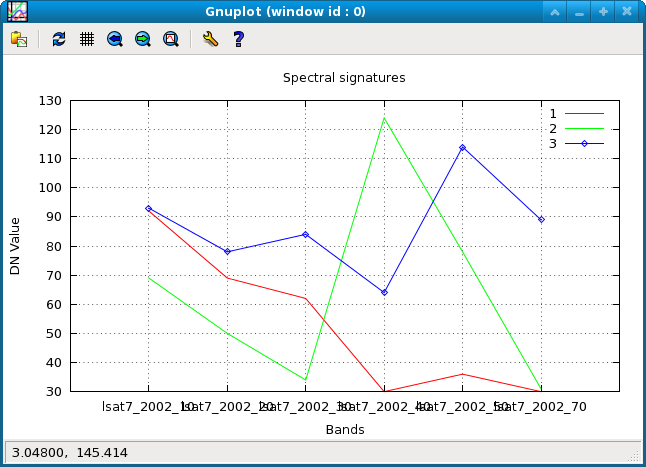
Note: A new GRASS GIS stable version has been released: GRASS GIS 7. Go directly to the new manual page here
NAME
i.spectral - Displays spectral response at user specified locations in group or images.
KEYWORDS
imagery, raster, multispectral
SYNOPSIS
i.spectral
i.spectral help
i.spectral [-imc] [group=string] [raster=string[,string,...]] [output=string] [--overwrite] [--verbose] [--quiet]
Flags:
- -i
- Use image list and not group
- -m
- Select multiple points
- -c
- Show pick coordinates instead of numbering in the legend
- --overwrite
- Allow output files to overwrite existing files
- --verbose
- Verbose module output
- --quiet
- Quiet module output
Parameters:
- group=string
- Group input
- raster=string[,string,...]
- Raster input maps
- output=string
- Write output to PNG image
DESCRIPTION
i.spectral displays spectral response at user specified
locations in images.
NOTES
This script needs gnuplot to be installed.
EXAMPLES
Analysis of LANDSAT TM7 channels (North Carolina dataset):
g.region rast=lsat7_2002_10 -p
d.mon x0
d.rast lsat7_2002_40
i.spectral -i rast=lsat7_2002_10,lsat7_2002_20,lsat7_2002_30,lsat7_2002_40,lsat7_2002_50,lsat7_2002_70

Spectral plot of 3 different land cover types: (1) water, (2) green vegetation, and (3) highway
To analyze a time series of maps, use:
d.rast map_1
LIST=`g.mlist type=rast mapset=timeseries pat="map_*" | sort -t '_' -k 2 -n | tr '\n' ','| sed 's+,$++g'`
i.spectral -i rast=$LIST
SEE ALSO
d.what.rast
d.where
r.what
AUTHOR
Markus Neteler
Francesco Pirotti
Last changed: $Date: 2012-08-20 03:35:34 -0700 (Mon, 20 Aug 2012) $
Main index - imagery index - Full index
© 2003-2016 GRASS Development Team


